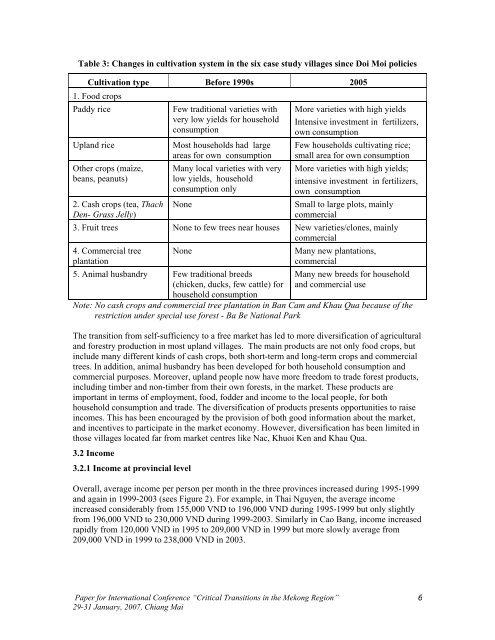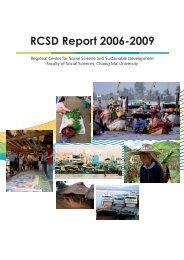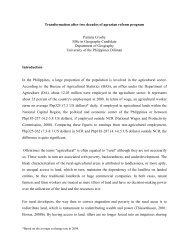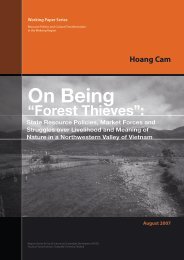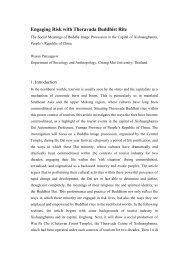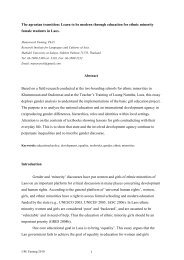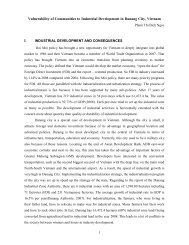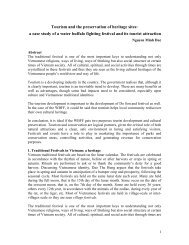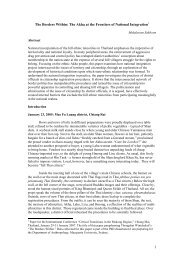The Impact of the Renovation Policies on the Livelihoods of ... - RCSD
The Impact of the Renovation Policies on the Livelihoods of ... - RCSD
The Impact of the Renovation Policies on the Livelihoods of ... - RCSD
Create successful ePaper yourself
Turn your PDF publications into a flip-book with our unique Google optimized e-Paper software.
Table 3: Changes in cultivati<strong>on</strong> system in <str<strong>on</strong>g>the</str<strong>on</strong>g> six case study villages since Doi Moi policiesCultivati<strong>on</strong> type Before 1990s 20051. Food cropsPaddy riceFew traditi<strong>on</strong>al varieties with More varieties with high yieldsvery low yields for household Intensive investment in fertilizers,c<strong>on</strong>sumpti<strong>on</strong>own c<strong>on</strong>sumpti<strong>on</strong>Upland riceO<str<strong>on</strong>g>the</str<strong>on</strong>g>r crops (maize,beans, peanuts)2. Cash crops (tea, ThachDen- Grass Jelly)Most households had largeareas for own c<strong>on</strong>sumpti<strong>on</strong>Many local varieties with verylow yields, householdc<strong>on</strong>sumpti<strong>on</strong> <strong>on</strong>lyN<strong>on</strong>eFew households cultivating rice;small area for own c<strong>on</strong>sumpti<strong>on</strong>More varieties with high yields;intensive investment in fertilizers,own c<strong>on</strong>sumpti<strong>on</strong>Small to large plots, mainlycommercial3. Fruit trees N<strong>on</strong>e to few trees near houses New varieties/cl<strong>on</strong>es, mainlycommercial4. Commercial tree N<strong>on</strong>eplantati<strong>on</strong>5. Animal husbandry Few traditi<strong>on</strong>al breeds(chicken, ducks, few cattle) forMany new plantati<strong>on</strong>s,commercialMany new breeds for householdand commercial usehousehold c<strong>on</strong>sumpti<strong>on</strong>Note: No cash crops and commercial tree plantati<strong>on</strong> in Ban Cam and Khau Qua because <str<strong>on</strong>g>of</str<strong>on</strong>g> <str<strong>on</strong>g>the</str<strong>on</strong>g>restricti<strong>on</strong> under special use forest - Ba Be Nati<strong>on</strong>al Park<str<strong>on</strong>g>The</str<strong>on</strong>g> transiti<strong>on</strong> from self-sufficiency to a free market has led to more diversificati<strong>on</strong> <str<strong>on</strong>g>of</str<strong>on</strong>g> agriculturaland forestry producti<strong>on</strong> in most upland villages. <str<strong>on</strong>g>The</str<strong>on</strong>g> main products are not <strong>on</strong>ly food crops, butinclude many different kinds <str<strong>on</strong>g>of</str<strong>on</strong>g> cash crops, both short-term and l<strong>on</strong>g-term crops and commercialtrees. In additi<strong>on</strong>, animal husbandry has been developed for both household c<strong>on</strong>sumpti<strong>on</strong> andcommercial purposes. Moreover, upland people now have more freedom to trade forest products,including timber and n<strong>on</strong>-timber from <str<strong>on</strong>g>the</str<strong>on</strong>g>ir own forests, in <str<strong>on</strong>g>the</str<strong>on</strong>g> market. <str<strong>on</strong>g>The</str<strong>on</strong>g>se products areimportant in terms <str<strong>on</strong>g>of</str<strong>on</strong>g> employment, food, fodder and income to <str<strong>on</strong>g>the</str<strong>on</strong>g> local people, for bothhousehold c<strong>on</strong>sumpti<strong>on</strong> and trade. <str<strong>on</strong>g>The</str<strong>on</strong>g> diversificati<strong>on</strong> <str<strong>on</strong>g>of</str<strong>on</strong>g> products presents opportunities to raiseincomes. This has been encouraged by <str<strong>on</strong>g>the</str<strong>on</strong>g> provisi<strong>on</strong> <str<strong>on</strong>g>of</str<strong>on</strong>g> both good informati<strong>on</strong> about <str<strong>on</strong>g>the</str<strong>on</strong>g> market,and incentives to participate in <str<strong>on</strong>g>the</str<strong>on</strong>g> market ec<strong>on</strong>omy. However, diversificati<strong>on</strong> has been limited inthose villages located far from market centres like Nac, Khuoi Ken and Khau Qua.3.2 Income3.2.1 Income at provincial levelOverall, average income per pers<strong>on</strong> per m<strong>on</strong>th in <str<strong>on</strong>g>the</str<strong>on</strong>g> three provinces increased during 1995-1999and again in 1999-2003 (sees Figure 2). For example, in Thai Nguyen, <str<strong>on</strong>g>the</str<strong>on</strong>g> average incomeincreased c<strong>on</strong>siderably from 155,000 VND to 196,000 VND during 1995-1999 but <strong>on</strong>ly slightlyfrom 196,000 VND to 230,000 VND during 1999-2003. Similarly in Cao Bang, income increasedrapidly from 120,000 VND in 1995 to 209,000 VND in 1999 but more slowly average from209,000 VND in 1999 to 238,000 VND in 2003.Paper for Internati<strong>on</strong>al C<strong>on</strong>ference “Critical Transiti<strong>on</strong>s in <str<strong>on</strong>g>the</str<strong>on</strong>g> Mek<strong>on</strong>g Regi<strong>on</strong>”29-31 January, 2007, Chiang Mai6


